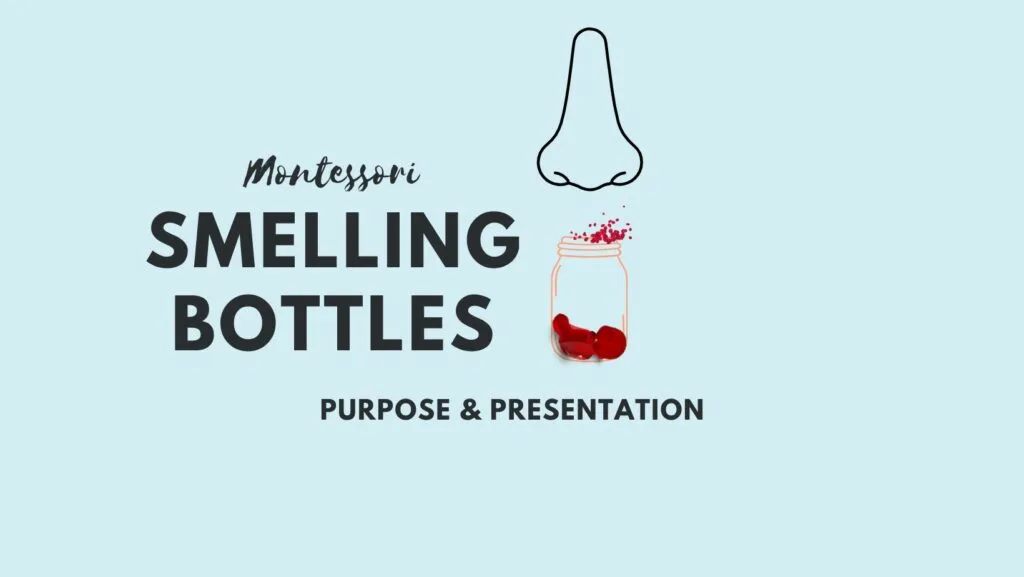Are you interested in learning about the Montessori Smelling Bottles? If so, you've come to the right place.
Today, we're going to learn about the importance of refining a child's sense of smell.
We'll also learn about what the Montessori Smelling Bottles are, how to present them in a homeschool setting or classroom, and how to make them yourself.
Let's get right to it.

(This post contains affiliate links. Purchasing from these links costs you nothing extra, but helps with our website upkeep.)
The importance of the sense of smell in Montessori
The Montessori Method emphasizes allowing children to learn through their senses, and the olfactory sense is not left out of the Method.
Our sense of smell is controlled by the limbic system and is connected to memory, behavior, and emotion.
It can alert us to danger and help keep us healthy in a number of ways.
Without a properly developed sense of smell, food does not taste the same. This can lead people to undereat or oversalt their food, which can lead to a number of health issues.
Sense of smell also helps us enjoy life. Being able to enjoy the subtle scents of fresh air, snow, and rain is a result of having a refined olfactory sense.
What are Smelling Bottles in Montessori?
The Smelling Bottles is a sensorial material in Montessori that consists of 12 small plastic or glass bottles with pierced caps, divided into 2 sets.
Each set has different colored lids.
Many Montessori schools use water in the bottles that contain a small number of liquid scent drops, however, some choose to use cotton balls to hold the scent.
This is a pairing (matching) activity, which means that there will be the same scents in each set of bottles.
For example, the set of Smelling Bottles with brown lids might have one peppermint-scented bottle.
If this is the case, the set of bottles with white lids should also have one peppermint-scented bottle.
Below is a set of smelling bottles commonly used for Montessori homeschooling. Many prefer these as they can be used for many other purposes.
This set is similar to what you would find in a Montessori classroom, though it is a bit more expensive and less versatile than some DIY options. (Which I'll go over toward the end of the article.)
Purpose of the Montessori Smelling Bottles
The purpose of the Smelling Bottles material is to help develop a child's sense of smell, or olfactory sense, so they can discriminate between scents.
Another aim of this activity is to help develop a child's olfactory memory.
This is the ability to recognize scents and relate them to emotions or experiences.
Control of error
The control of error for the Smelling Bottles is the child's own sense of smell.
You will have to arrange the Smelling Bottles ahead of time so that you know which bottles have which scents.
You should also place small stickers on the bottoms of the bottles that mark the scents.
How to present the Montessori Smelling Bottles lesson
- Take the boxes along with the child to the work table. They should carry one, while you carry the other.
- Set the boxes on top of their lids and move them to the upper left corner of the work area.
- Let the child know that you're going to match the bottles by their scent.
- Choose a Smelling Bottle (ex: peppermint) from the first set, remove the cap, and place it on the table to the right of the boxes.
- Waft the scent to your nose and ask the child to do the same.
- Put the Smelling Bottle down on the table.
- Choose another Smelling Bottle (ex: lavender) from the first set and repeat the previous steps.
- Chose the lavender bottle from the second set of bottles and ask the child to waft the scent.
- Ask the child if it is the same as the last one they smelled.
- If the child is correct, place the pair side-by-side toward the top of the work area.
- Select the peppermint Smelling Bottle from the second set and again ask the child to smell it to see if it matches the other bottle that is in front of them.
- Again place the match to the top of the workspace.
- Shuffle the 4 bottles and invite the child to pair them again.
- Pair by pair, add the remaining Smelling Bottles to the activity.
After you present this lesson, but on a different day, you can present the Smelling Bottles along with their corresponding 3-part cards for a vocabulary lesson.
After your child has worked with the Smelling Bottles for some time and is ready for a greater challenge, you can present this activity with smaller amounts of scent drops for more subtle smells.
DIY Montessori Smelling Bottles
The Smelling Bottles that come in the sets that you buy already have a do-it-yourself element to them.
After all, you have to find the scents you will use and place them in water in the smelling jars.
If you want a more affordable way to do the Smelling Bottles, though, you can make them yourself.
Below, I've linked some low-cost plastic bottles.
To make your own Smelling Bottles, you will be painting 6 lids a different color and leaving 6 lids red. I recommend acrylic paint for this job.
If you already have empty spice bottles with different colored lids, that's an even better money-saver.
You can add scents like:

Montessori Smelling Bottles are so much fun to present to your child. I just love this activity.
Children get so excited when they're able to match the scents.
Have you done this activity in your home? What scents did your child enjoy pairing the most?
Cheers and don't forget to subscribe!
